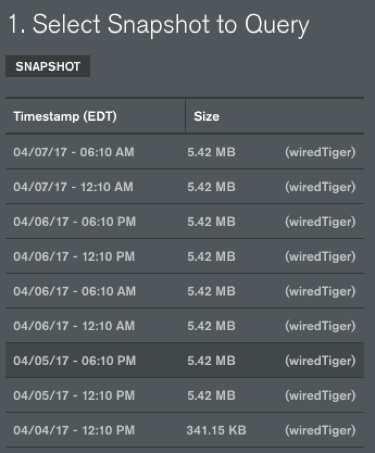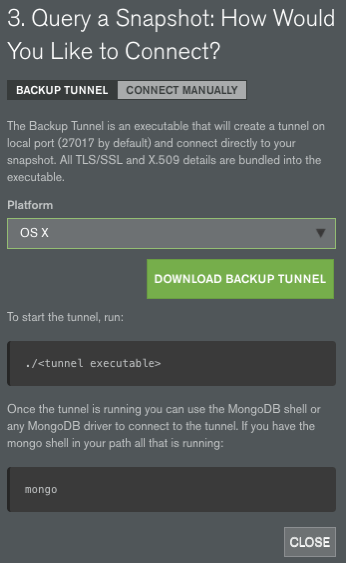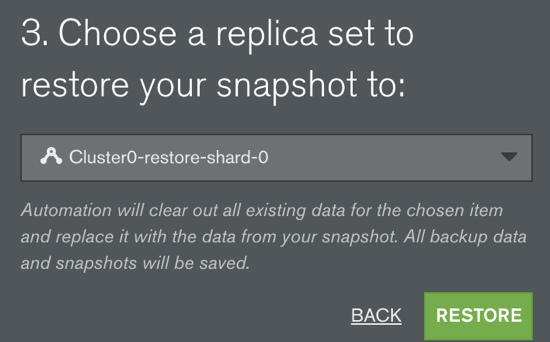You can get started with MongoDB and your favorite programming language by leveraging one of its drivers, many of which are maintained by MongoDB engineers, and others which are maintained by members of the community. MongoDB has a native Python driver, PyMongo, and a team of Driver engineers dedicated to making the driver fit to the Python community’s needs.
In this article, which is aimed at Python developers who are new to MongoDB, you will learn how to do the following:
- Create a free hosted MongoDB database using MongoDB Atlas
- Install PyMongo, the Python Driver
- Connect to MongoDB
- Explore MongoDB Collections and Documents
- Perform basic Create, Retrieve, Update and Delete (CRUD) operations using PyMongo
Let’s get started!
You can start working immediately with MongoDB by using a free MongoDB cluster via MongoDB Atlas. MongoDB Atlas is a hosted database service that allows you to choose your database size and get a connection string! If you are interested in using the free tier follow the instructions in the Appendix section at the end of this article.
Install the Python Driver
For this article we will install the Python driver called, “PyMongo”.
Although there are other drivers written by the community, PyMongo is the official Python driver for MongoDB. For a detailed documentation on the driver check out the documentation here.
The easiest way to install the driver is through the pip package management system. Execute the following on a command line:
python -m pip install pymongo
Note: If you are using the Atlas M0 (Free Tier) cluster, you must use Python 2.7.9+ and use a Python 3.4 or newer. You can check which version of Python and PyMongo you have installed by issuing “python --version” and “pip list” commands respectively.
For variations of driver installation check out the complete documentation:
Once PyMongo is installed we can write our first application that will return information about the MongoDB server. In your Python development environment or from a text editor enter the following code.
Replace the “<>” with your connection string to MongoDB. Save this file as “mongodbtest.py” and run it from the command line via, “python mongodbtest.py”
An example output appears as follows:
{u'asserts': {u'msg': 0,
u'regular': 0,
u'rollovers': 0,
u'user': 0,
u'warning': 0},
u'connections': {u'available': 96, u'current': 4, u'totalCreated': 174L},
u'extra_info': {u'note': u'fields vary by platform', u'page_faults': 0},
u'host': u'cluster0-shard-00-00-6czvq.mongodb.net:27017',
u'localTime': datetime.datetime(2017, 4, 4, 0, 18, 45, 616000),
.
.
.
}
Note that the ‘u’ character comes from the python output and it means that the strings are stored in unicode. This example also uses the pprint library which is not related to MongoDB but is used here only to make the output structured and visually appealing from a console.
In this example we are connecting to our MongoDB instance and issuing the “db.serverStatus()” command (reference). This command returns information about our MongoDB instance and is used in this example as a way to execute a command against MongoDB.
If your application runs successfully, you are ready to continue!
Exploring Collections and Documents
MongoDB stores data in documents. Documents are not like Microsoft Word or Adode PDF documents but rather JSON documents based on the JSON specification.
An example of a JSON document would be as follows:
![JSON document example]() Figure 1: Sample document
Figure 1: Sample document
Notice that documents are not just key/value pairs but can include arrays and subdocuments. The data itself can be different data types like geospatial, decimal, and ISODate to name a few. Internally MongoDB stores a binary representation of JSON known as BSON. This allows MongoDB to provide data types like decimal that are not defined in the JSON specification. For more information on the BSON spec check out the following URL: http://bsonspec.org.
A collection in MongoDB is a container for documents. A database is the container for collections. This grouping is similar to relational databases and is pictured below:
| Relational concept |
MongoDB equivalent |
| Database |
Database |
| Tables |
Collections |
| Rows |
Documents |
| Index |
Index |
There are many advantages to storing data in documents. While a deeper discussion is out of the scope of this article, some of the advantages like dynamic, flexible schema, and the ability to store arrays can be seen from our simple Python scripts. For more information on MongoDB document structure take a look at the online documentation at the following URL: https://docs.mongodb.com/manual/core/document/.
Let’s take a look at how to perform basic CRUD operations on documents in MongoDB using PyMongo.
To establish a connection to MongoDB with PyMongo you use the MongoClient class.
from pymongo import MongoClient
client = MongoClient('<<MongoDB URL>>’)
The “<<MongoDB URL>>”is a placeholder for the connection string to MongoDB. See the connection string documentation for detail information on how to create your MongoDB connection string. If you are using Atlas for your MongoDB database, refer to the “testing your connection” section for more information on obtaining the connection string for MongoDB Atlas.
We can now create a database object referencing a new database, called “business”, as follows:
db = client.business
Once we create this object we can perform our CRUD operations. Since we want something useful to query let’s start by building a sample data generator application.
Generating sample data code example
Create a new file called createsamples.py using your development tool or command line text editor and copy the following code:
Be sure to change the MongoDB client connection URL to one that points to your MongoDB database instance. Once you run this application, 500 randomly named businesses with their corresponding ratings will be created in the MongoDB database called, “business”. All of these businesses are created in a single collection called, “reviews”. Notice that we do not have to explicitly create a database beforehand in order to use it. This is different from other databases that require statements like, “CREATE DATABASE” to be performed first.
The command that inserts data into MongoDB in this example is the insert_one() function. A bit self-explanatory, insert_one will insert one document into MongoDB. The result set will return the single ObjectID that was created. This is one of a few methods that insert data. If you wanted to insert multiple documents in one call you can use the insert_many function. In addition to an acknowledgement of the insertion, the result set for insert_many will include a list of the ObjectIDs that were created. For more information on insert_many see the documentation located here.
For details on the result set of insert_many check out this section of documentation as well.
We are now ready to explore querying and managing data in MongoDB using Python. To guide this exploration we will create another application that will manage our business reviews.
Exploring business review data
Now that we have a good set of data in our database let’s query for some results using PyMongo.
In MongoDB the find_one command is used to query for a single document much like select statements are used in relational databases. To use the find_one command in PyMongo we pass a Python dictionary that specifies the search criteria. For example, let’s find a single business with a review score of 5 by passing the dictionary, “{ ‘rating’ : 5 } “.
fivestar = db.reviews.find_one({'rating': 5})
print(fivestar)
The result will contain data similar to the following:
{u'rating': 5,
u'_id': ObjectId('58e65383ea0b650c867ef195'),
u'name': u'Fish Salty Corporation',
u'cuisine': u'Sushi Bar'}
Given we created 500 sample pieces of data there is more than one business with rating 5. The find_one method is just one in a series of find statements that support querying MongoDB data. Another statement, called “find”, will return a cursor over all documents that match the search criteria. These cursors also support methods like count() which returns the number of results in the query. To find the total count of businesses that are rated with a 5 we can use the count() method as follows:
fivestarcount = db.reviews.find({'rating': 5}).count()
print(fivestarcount)
Your results may vary since the data was randomly generated but in a test run the value of 103 was returned.
MongoDB can easily perform these straightforward queries. However, consider the scenario where you want to sum the occurrence of each rating across the entire data set. In MongoDB you could create 5 separate find queries, execute them and present the results, or you could simply issue a single query using the MongoDB aggregation pipeline as follows:
A deep dive into the aggregation framework is out of scope of this article, however, if you are interested in learning more about it check out the following URL: https://docs.mongodb.com/manual/aggregation/.
Updating data with PyMongo
Similar to insert_one and insert_many there exists functions to help you update your MongoDB data including update_one, update_many and replace_one. The update_one method will update a single document based on a query that matches a document. For example, let’s assume that our business review application now has the ability for users to “like” a business. To illustrate updating a document with this new “likes” field, let’s first take a look at what an existing document looks like from our previous application’s insertion into MongoDB. Next, let’s update the document and requery the document and see the change.
When running the sample code above you may see results similar to the following:
A sample document:
{'_id': ObjectId('58eba417ea0b6523b0fded4f'),
'cuisine': 'Pizza',
'name': 'Kitchen Goat Corporation',
'rating': 1}
Number of documents modified : 1
The updated document:
{'_id': ObjectId('58eba417ea0b6523b0fded4f'),
'cuisine': 'Pizza',
'likes': 1,
'name': 'Kitchen Goat Corporation',
'rating': 1}
Notice that the original document did not have the “likes” field and an update allowed us to easily add the field to the document. This ability to dynamically add keys without the hassle of costly Alter_Table statements is the power of MongoDB’s flexible data model. It makes rapid application development a reality.
If you wanted to update all the fields of the document and keep the same ObjectID you will want to use the replace_one function. For more details on replace_one check out the pymongo documentation here.
The update functions also support an option called, “upsert”. With upsert you can tell MongoDB to create a new document if the document you are trying to update does not exist.
Deleting documents
Much like the other command discussed so far the delete_one and delete_many command takes a query that matches the document to delete as the first parameter. For example, if you wanted to delete all documents in the reviews collection where the category was “Bar Food” issue the following:
result = db.restaurants.delete_many({“category”: “Bar Food“})
If you are deleting a large number of documents it may be more efficient to drop the collection instead of deleting all the documents.
Where to go next
There are lots of options when it comes to learning about MongoDB and Python. MongoDB University is a great place to start and learn about administration, development and other topics such as analytics with MongoDB. One course in particular is MongoDB for Developers (Python). This course covers the topics of this article in much more depth including a discussion on the MongoDB aggregation framework. For more information go to the following URL:
https://university.mongodb.com/courses/M101P/about
Appendix: Creating a free tier MongoDB Atlas database
MongoDB Atlas is a hosted database service that allows you to choose your database size and get a connection string! Follow the steps below to start using your free
Build your cluster for free
Follow the below steps to create a free MongoDB database:
- Go to the following URL: https://www.mongodb.com/cloud/atlas.
- Click the “Start Free” button
- Fill out the form to create an account. You will use this information to later login and manage your MongoDB.
Once you fill out the form, the website will create your account and you will be presented with the “Build Your New Cluster” pop up as shown in Figure 1.
!["Build your new cluster"]()
To use the free tier scroll down and select, “M0”. When you do this the regions panel will be disabled. The free tier has some restrictions with the ability to select a region being one of them and your database size will be limited to 512MB of storage. Given that, when you are ready to use MongoDB for more than just some simple operations you can easily create another instance by choosing a size from the “Instance Size” list. Before you click “Confirm & Deploy” scroll down the page and notice the additional options shown in Figure 2.
![Additional options in Build New Cluster dialog]()
From the “Build Your New Cluster” pop up you can see that there are other options available including choosing a 3, 5 or 7 node replica set and up to a 12 shard cluster. Note that the free tier does not allow you to chose anything more than the 3 node cluster, but if you move into other sizes these options will become available. At this point we are almost ready; the last thing to address is the admin username and password. You may also choose to have a random password generated for you by clicking the “Autogenerate Secure Password” button. Finally, click the “Confirm & Deploy” button to create your Atlas cluster.
Setting up your IP Whitelist
While Atlas is creating your database you will need to define which IP’s are allowed access to your new database since MongoDB Atlas does not allow access from the internet by default. This list of granted IP addresses is called the “IP Whitelist”. To add the IP of your machine to this list click on the “Security” tab, then “IP Whitelist” then click the “+ ADD IP ADDRESS” button. This will pop up another dialog shown in Figure 3 below. You can click the “Add current IP Address” button to add your IP or provide a specific IP address or enable access to the world by not restricting IPs at all (not a fantastic idea but there in case you have no other choice and need to allow authentication from any IP).
![Add whitelist entry]()
Once you have filled out this dialog click “Confirm” and this will update the firewall settings on your MongoDB Atlas cluster. Next, click on the “Clusters” tab and you should see your new MongoDB database ready for action!
!["Cluster0" ready for action]()
Testing your connection
We want to make sure the MongoDB database is accessible from our development box before we start typing in code. A quick way to test is to make a connection using the Mongo Shell command line tool. Be sure to have your MongoDB connection information available. If you are using MongoDB Atlas you can obtain the connection information by clicking on the “Connect” button on the Clusters tab as shown in Figure 5.
![Connect button of the MongoDB Atlas cluster]()
The Connect button will launch a dialog that provides connection information. At the bottom of this dialog you will see a prepared command line ready for you to simply copy and paste in a command prompt.
![Connect with Mongo Shell section of the Connect dialog]()
Note that if you copy the connection text as-is you will have to replace with the password for the admin user, and with the name of the database to which you wish to connect.
The command text that comes from this dialog is lengthy. For clarity, let’s take a look at each of the parameters individually.
mongo
"mongodb://cluster0-shard-00-00-2ldwo.mongodb.net:27017,cluster0-shard-00-01-2ldwo.mongodb.net:27017,cluster0-shard-00-02-2ldwo.mongodb.net:27017/test?replicaSet=Cluster0-shard-0"
--authenticationDatabase admin
--ssl
--username myadmin
--password S$meComPLeX1!
The first parameter is a string containing the list of all the nodes in our cluster including the definition of a replica set called, “Cluster0-shard-0”. The next parameter, “--authenticationDatabase” tells which database contains the user we want to authenticate. The “--ssl” forces the connection to be encrypted via SSL/TLS protocol. Finally we provide the username and password, and we are connected! Note that if you are not using MongoDB Atlas, your MongoDB deployment may not have security enabled or require SSL. Thus, connecting to it could be as simple as typing “mongo” in the command prompt.
You are now ready to use MongoDB!
If you're interested in learning everything you need to know to get started building a MongoDB-based app you can sign up for one of our free online MongoDB University courses.






































 If you decide you'd like another Atlas cluster with your MongoDB data it only takes a few clicks. First, build your new Atlas cluster and name it something unique. Then go to the backup section in your Atlas control panel and select the backup you'd like to restore. It's important to ensure you restore to a like version cluster. That means restore MongoDB 3.2 database snapshots to MongoDB Atlas 3.2 clusters. The same goes for all MongoDB 3.4 clusters. You will not be able to mix and match versions of backup and cluster.
If you decide you'd like another Atlas cluster with your MongoDB data it only takes a few clicks. First, build your new Atlas cluster and name it something unique. Then go to the backup section in your Atlas control panel and select the backup you'd like to restore. It's important to ensure you restore to a like version cluster. That means restore MongoDB 3.2 database snapshots to MongoDB Atlas 3.2 clusters. The same goes for all MongoDB 3.4 clusters. You will not be able to mix and match versions of backup and cluster.






 Ansible allows you to execute complex playbooks from your local desktop computer; we’ll use it in this example to launch our MongoDB Atlas cluster.
Ansible allows you to execute complex playbooks from your local desktop computer; we’ll use it in this example to launch our MongoDB Atlas cluster.  Figure 1: Q-Suite recording of all digital interactions for regulatory compliance
Figure 1: Q-Suite recording of all digital interactions for regulatory compliance Figure 2: Analysis of funnel metrics to monitor customer conversion through digital properties
Figure 2: Analysis of funnel metrics to monitor customer conversion through digital properties












